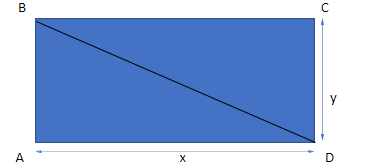Answer
398.4k+ views
Hint:Let the length and width of the rectangle be x and y . As we know the formula to calculate the area of the rectangle which is \[{\text{A = x}}{\text{.y}}\] and ratio of x and y is also given. So , finally we just have to calculate the length of the diagonal after finding out the value of x and y.
Complete step-by-step answer:

Here we can see that as \[\vartriangle {\text{ABD is }} \bot \](right angle triangle) , so we can calculate length of triangle directly by applying Pythagoras theorem in \[\vartriangle {\text{ABD}}\]. So, length of diagonal is \[\sqrt {{{\text{x}}^{\text{2}}}{\text{ + }}{{\text{y}}^{\text{2}}}} \].
As area of rectangle is \[{\text{300c}}{{\text{m}}^{\text{2}}}\]and the ratio of sides is \[{\text{3:4}}\],
Hence, \[\dfrac{{\text{x}}}{{\text{y}}}{\text{ = }}\dfrac{{\text{3}}}{{\text{4}}}\] and \[{\text{x}}{\text{.y = 300}}\]
While solving both the equation we can simplify them as
\[
{\text{4x = 3y}} \\
{\text{x}}{\text{.y = 100}} \\
\]
Substitute the value of x from one equation and put it into the another equation,
\[ \Rightarrow {\text{x = }}\dfrac{{{\text{3y}}}}{{\text{4}}}\]
On substituting in \[{\text{x}}{\text{.y = 300,}}\]
\[
\Rightarrow \dfrac{{{\text{3y}}}}{{\text{4}}}{\text{.y = 300}} \\
\Rightarrow {{\text{y}}^{\text{2}}}{\text{ = 400}} \\
\]
On taking root we get,
\[ \Rightarrow y = 20\]
Now , again placing the value of y in the substituted equation in order to obtain value of x.
\[
\Rightarrow {\text{x = }}\dfrac{{{\text{3(20)}}}}{{\text{4}}} \\
\Rightarrow {\text{x = 15}} \\
\]
Hence , on solving both the above equations we can reach up to the conclusion as
\[
{\text{x = 15cm}} \\
{\text{y = 20cm}} \\
\]
Now, length of diagonal is \[\sqrt {{{\text{x}}^{\text{2}}}{\text{ + }}{{\text{y}}^{\text{2}}}} \]
\[
{\text{ = }}\sqrt {{\text{1}}{{\text{5}}^{\text{2}}}{\text{ + 2}}{{\text{0}}^{\text{2}}}} \\
{\text{ = }}\sqrt {{\text{ 225 + 400}}} \\
{\text{ = }}\sqrt {{\text{625}}} \\
{\text{ = }}\sqrt {{\text{2}}{{\text{5}}^{\text{2}}}} \\
{\text{ = 25cm}} \\
\]
Hence , option (d) is our required correct answer.
Note: A rectangle has two diagonals. Each one is a line segment drawn between the opposite vertices (corners) of the rectangle. The diagonals have the following properties:
The two diagonals are of the same length. Each diagonal divides the rectangle into two congruent right triangles. Because the triangles are congruent, they have the same area, and each triangle has half the area of the rectangle
Complete step-by-step answer:

Here we can see that as \[\vartriangle {\text{ABD is }} \bot \](right angle triangle) , so we can calculate length of triangle directly by applying Pythagoras theorem in \[\vartriangle {\text{ABD}}\]. So, length of diagonal is \[\sqrt {{{\text{x}}^{\text{2}}}{\text{ + }}{{\text{y}}^{\text{2}}}} \].
As area of rectangle is \[{\text{300c}}{{\text{m}}^{\text{2}}}\]and the ratio of sides is \[{\text{3:4}}\],
Hence, \[\dfrac{{\text{x}}}{{\text{y}}}{\text{ = }}\dfrac{{\text{3}}}{{\text{4}}}\] and \[{\text{x}}{\text{.y = 300}}\]
While solving both the equation we can simplify them as
\[
{\text{4x = 3y}} \\
{\text{x}}{\text{.y = 100}} \\
\]
Substitute the value of x from one equation and put it into the another equation,
\[ \Rightarrow {\text{x = }}\dfrac{{{\text{3y}}}}{{\text{4}}}\]
On substituting in \[{\text{x}}{\text{.y = 300,}}\]
\[
\Rightarrow \dfrac{{{\text{3y}}}}{{\text{4}}}{\text{.y = 300}} \\
\Rightarrow {{\text{y}}^{\text{2}}}{\text{ = 400}} \\
\]
On taking root we get,
\[ \Rightarrow y = 20\]
Now , again placing the value of y in the substituted equation in order to obtain value of x.
\[
\Rightarrow {\text{x = }}\dfrac{{{\text{3(20)}}}}{{\text{4}}} \\
\Rightarrow {\text{x = 15}} \\
\]
Hence , on solving both the above equations we can reach up to the conclusion as
\[
{\text{x = 15cm}} \\
{\text{y = 20cm}} \\
\]
Now, length of diagonal is \[\sqrt {{{\text{x}}^{\text{2}}}{\text{ + }}{{\text{y}}^{\text{2}}}} \]
\[
{\text{ = }}\sqrt {{\text{1}}{{\text{5}}^{\text{2}}}{\text{ + 2}}{{\text{0}}^{\text{2}}}} \\
{\text{ = }}\sqrt {{\text{ 225 + 400}}} \\
{\text{ = }}\sqrt {{\text{625}}} \\
{\text{ = }}\sqrt {{\text{2}}{{\text{5}}^{\text{2}}}} \\
{\text{ = 25cm}} \\
\]
Hence , option (d) is our required correct answer.
Note: A rectangle has two diagonals. Each one is a line segment drawn between the opposite vertices (corners) of the rectangle. The diagonals have the following properties:
The two diagonals are of the same length. Each diagonal divides the rectangle into two congruent right triangles. Because the triangles are congruent, they have the same area, and each triangle has half the area of the rectangle
Recently Updated Pages
Three beakers labelled as A B and C each containing 25 mL of water were taken A small amount of NaOH anhydrous CuSO4 and NaCl were added to the beakers A B and C respectively It was observed that there was an increase in the temperature of the solutions contained in beakers A and B whereas in case of beaker C the temperature of the solution falls Which one of the following statements isarecorrect i In beakers A and B exothermic process has occurred ii In beakers A and B endothermic process has occurred iii In beaker C exothermic process has occurred iv In beaker C endothermic process has occurred

The branch of science which deals with nature and natural class 10 physics CBSE

The Equation xxx + 2 is Satisfied when x is Equal to Class 10 Maths

Define absolute refractive index of a medium

Find out what do the algal bloom and redtides sign class 10 biology CBSE

Prove that the function fleft x right xn is continuous class 12 maths CBSE

Trending doubts
Difference Between Plant Cell and Animal Cell

Difference between Prokaryotic cell and Eukaryotic class 11 biology CBSE

Fill the blanks with the suitable prepositions 1 The class 9 english CBSE

Change the following sentences into negative and interrogative class 10 english CBSE

Summary of the poem Where the Mind is Without Fear class 8 english CBSE

Give 10 examples for herbs , shrubs , climbers , creepers

Write an application to the principal requesting five class 10 english CBSE

What organs are located on the left side of your body class 11 biology CBSE

What is the z value for a 90 95 and 99 percent confidence class 11 maths CBSE



